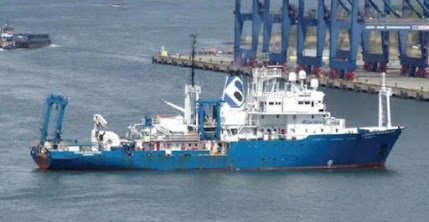Illegal trawlers fishing right off New Jersey coastline
The amount
of fishing misinformation out there on social media is enough to make me crazy and
inspired this blog post. Take a deeper dive into the world of offshore wind power
with me and learn more about what these weird-looking ships are and why they
are there.
These ships may
be big and weird-looking, but I assure you they aren’t “Chinese trawlers” or “Omega
Bunker boats” netting up millions of pounds of fish. In fact, there isn’t a
single fish hook or net onboard. They are Research vessels hired by offshore
wind developers to perform surveys of the ocean floor on the coming windfarms.
This is all part of the planning process to explore not only the actual turbine
locations but all the cable routes.
Those tall
structures (A-Frames) that you see on deck tow the sonar arrays behind the
vessel and map the seafloor. The other tall towers on some ships are for doing
the core sampling. Some of the larger vessels even have a helicopter landing
pad on the bow giving the ship an odd profile when seen offshore. They are working
24-hour days providing sea conditions allow them to get clear data from the
sonar gear.
The offshore
wind developers in our area, Equinor, Orsted, Atlantic Shores, etc. bid on lease
areas that are put out to bid by BOEM. When they win the bid, that gives them
the right to explore the lease area. Know that the lease areas are very large
looking on charts, only smaller sections or parcels will have turbines on them.
Right now, there are an additional 8 areas pending bidding in the NYNJ Bight.
As you can
imagine, there are a lot of rules and regulations that apply here along with
the dozens of acronyms used to communicate quickly in the industry. You have
BOEM which is the Bureau of Offshore Energy management, basically the landlords
of federal waters (3 to 200 miles), and NOAA National Oceanographic and
Atmospheric administration and NMFS which is the National Marine Fisheries
Service.
On each
vessel, there are 4-6 protected species observers (PSO’s) that are on constant
watch around the clock for all types of whales, dolphins, and turtles as all of
these are protected species. During daylight, they watch visually, but at night
they use a variety of instruments to acoustically detect them. When one of
these creatures is detected, there are specific mitigation procedures that are
followed and reported to the above entities. A single turtle present in the
survey area could shut them down and prevent the gathering of data for hours.
This is done at great time and expense to all parties involved, and once all-clear is sounded they get back to work.
The
survey vessels are good stewards of our coastal waters. They spend countless
hours at sea. This means they come across many things. From reporting and
retrieving abandoned fishing gear and if possible, returning to the owner, to
balloon & plastic debris removal, or even assisting vessels in distress.
The survey vessels also collect valuable data for scientific research. The
entire effort is aimed at improving our environment both above and below the
waves.










Nice job Paul.
ReplyDeleteVery helpful and informative - I'll be sure mention the post and link in my next post.
Best -
Paul Forsberg
www.OffshoreWindFarmSupport.com
Great post! You offered a very thorough description of the state of the budding Offshore Wind Industry in the Northeast, specific to some vessels and the means by which they are working to begin build out of the grids of Wind Farms. I would like to add that the one small thing you missed are WHO actually does the communicating and reporting FROM Survey vessels as work on grids with Fishing vessels are working same. Their position is called an ONBOARD Fisheries Liaison Officer- (OFL's/FLO's for short) We need them to be mandated such as the PSO's are mandated onboard. We would love to discuss at length with you for future information as it happens in the industry! https://OffshoreWindFarmSupport.com Best, Troy Forsberg
ReplyDelete